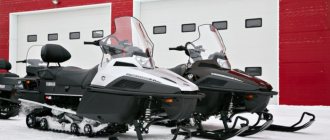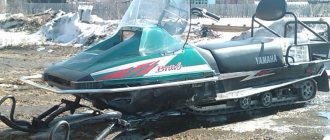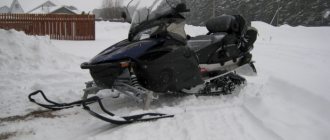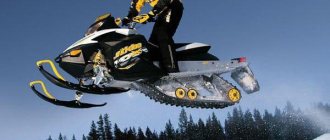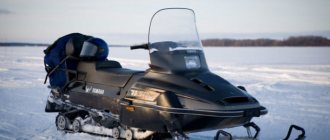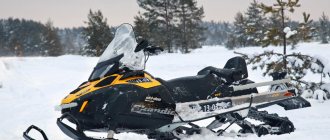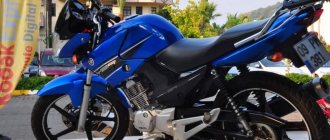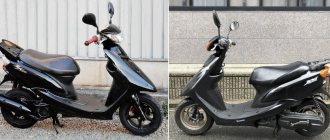Yamaha Bravo 250 is a reliable and affordable snowmobile made in Japan. The model is perfect for beginners, as it has a simplified design and is easy to operate. Low fuel consumption allows you to cover long distances without refueling. Harsh conditions are no problem for the Yamaha Bravo. The snowmobile can be used both in thaws and in severe frosts in deep snow. Wide tracks and low weight allow the equipment to pass through the most difficult places, even with a trailer.
Appearance and equipment
Externally, the model looks angular, but this is due to the fact that manufacturers adhere to the style of the predecessors of the Yamaha Bravo 250 T. The first snowmobiles of the Bravo series appeared back in 1982. Global restyling took place in 1992. From that moment on, the design of the bike did not change anymore. It is the familiar features that distinguish these winter motorcycles from other vehicles. The consistency of the design only speaks of its efficiency and high quality.
In terms of design, the snowmobile is very simple: a durable steel frame, a reliable two-stroke engine, suspension on semi-elliptical springs and a manual starter. Only the speedometer and odometer are displayed on the dashboard. The Bravo 250 does not have reverse gear - its low weight allows you to lift and rearrange the snow bike manually by grasping the tubular “rail” or trunk railing. The parking brake uses a brake lever on the handlebar, which is secured with a simple latch.
The basic configuration includes a primer (additional fuel injection pump), which allows fuel to be delivered directly to the receiving manifold. Thanks to this, it is possible to start the engine in any weather conditions. On the left behind the glass there is a variator covered with a casing, on the right there is a capacious gas tank and brake. In the engine compartment there is a small box with road tools and an emergency start cord.
| Dimensions | |
| Length | 2950 mm |
| Width | 950 mm |
| Height | 1120 mm |
| Ski track (distance from centers) | 750 mm |
| Track dimensions | |
| Length | 3455 mm |
| Width | 380 mm |
| Grouser height | 19 mm |
Snowmobile YAMAHA Bravo T
DESIGN and FILLING
The angular shape of the car immediately suggests that this model is one of the long-lived ones. Indeed, snowmobiles with the “Bravo” index date back to 1982, and in their current form, apart from minor changes, have been produced since 1992. However, if the company had carried out a radical modernization, it would no longer be the “Bravo”, the famous to thousands of snowmobilers around the world, and the consistency of the design, proven over the years, only indicates that it has proven successful.
The car is extremely simple - a single-cylinder, two-stroke 18-horsepower engine with forced air cooling (though with separate lubrication), a manual starter, ski suspension on semi-elliptical springs... The only instruments are a speedometer with an odometer, marked up to 160 km/h. Know ours! There is no reverse gear, but it is not needed here - by grasping the fence of the spacious rear trunk or the tubular “rail” surrounding the hood, the snowmobile can be easily lifted and rearranged manually. To get a shot from the track side, we stood him on his butt with just the two of us! The role of the parking brake is performed by an ordinary brake lever on the steering wheel, which is locked in the pressed state with a simple latch - just like on the clutch lever of a moped with a D-6 engine from distant childhood.
In addition to the usual air damper, the drive of which is made in the form of a lever that flips up and down, the standard equipment of “Bravo”, supplied to especially cold, according to the Japanese, Russia and Canada, also includes a primer - with a pump built into the dashboard you can inject fuel directly into receiving manifold. After a couple of pumps with the primer and two tugs of the starter cord, the handle of which protrudes from the dashboard directly in front of the driver, the engine started up willingly. Leaving the car to warm up with the brake locked, I folded the plastic hood with a high windshield forward and looked inside.
Everything is as simple as a rake, and everything is in plain sight. On the left is a variator covered with a casing, on the right is the main 15-liter gas tank and a disc brake with a cable drive, in the middle the ribs of the cylinder head enclosed in the air duct gleam and a spark plug sticks out. I immediately figured that if there was a special need, the variator belt could be replaced without any problems even in an open field, and the steering joints could also be easily accessed. In fact, there is an opinion that it is better not to mess with imported equipment yourself - they say that only specially trained craftsmen can handle repairs and adjustments. As far as I could tell, this has nothing to do with Bravo. Both maintenance and repairs here, in my opinion, are quite within the capabilities of an ordinary citizen whose hands grow from the right place.
According to those who have driven a lot on the Bravo, the main tank lasts for an average of 100 km, although much, of course, depends on the “road”. The additional fuel tank is also quite large - 9.3 liters. It is located under a cover on the front panel along with a 1.8-liter oil tank. Transparent tubes are provided to monitor the level of gasoline and oil.
In the engine compartment there was also room for a box with a minimum set of road tools (alas, there is no spare spark plug here) and an emergency start cord. I’ll say right away that it’s better not to let things get to the point where the main starter fails—you’ll suffer. The cord is simply wound around the slippery flywheel of the variator, which does not have any pulley, and is secured with a plastic bobbin. Personally, I managed to crank the engine with the emergency cord only on the fifth attempt - the loops stubbornly slipped off the flywheel. The suspension of the skis, as already noted, is spring, while that of the track is spring (lever springs work here on approximately the same principle as in a clothespin). Both the front and rear suspensions are equipped with hydraulic shock absorbers.
ON SNOW AND ICE
I was able to carry out road trials of the Bravo snowmobile in a wide variety of conditions - I rode it on the snow-covered ice of Lake Kavgolovskoe, on broken forest paths, and just in the forest. I really liked the precise operation of the variator: the engine rotated regularly in the most favorable speed range both during acceleration and on the easy “road” of the lake, where we managed to exceed the 70 km/h line, and in deep snow and on steep hills. The 18-horsepower engine, of course, is not a “sportsman,” but the car’s throttle response is quite sufficient. On compacted snow or ice powdered with snow, you can even turn around on the spot by adding gas and letting the track skid (“a police turn” using the brake was no less successful). The radius of a “normal” turn, without skidding, also turned out to be small - slightly more than the length of the snowmobile itself. “Bravo” confidently overcomes significant climbs - the maximum steepness of the slope is limited only by the adhesion properties of the caterpillar under certain snow conditions. The suspension, although short-travel (100 mm), absorbs road irregularities quite well, providing a satisfactory smooth ride even at high speeds. But when turning, you should be more careful - if you overdo it with speed or shift the steering wheel, the Bravo tends to fall outward, even if you competently transfer your body weight inward. A couple of times on sharp bends in the forest paths I had to hastily push off with my foot to avoid tipping over, but since the car is light, it did not require much effort. It’s not surprising - the Bravo ski track is only 750 mm, hence less stability. But the “minus” of a narrow gauge magically turns into a very serious “plus” - you can crawl into gaps between trees or steep ice hills that you wouldn’t be able to get into on a large “snowmobile”. And, in general, “Bravo” is not intended for a dashing race along winding roads. The machine is primarily a business one, and its tasks are more utilitarian. On a smooth “road,” the Bravo’s directional stability is excellent, but when encountering bumps, it was necessary to steer every now and then—obviously, some features of the completely independent, without a stabilizer, spring front suspension, as well as inevitable play in the steering system, affected it. When driving in deep snow, even loose snow, the Bravo practically does not fall through - this is due to the large supporting length of the track and the low weight of the snowmobile itself. Although according to the passport the snowmobile is a single-seater, I tried to take a passenger with me. You can drive, but without much comfort - you have to move close to the steering wheel, resting your knees on it. But the trunk volume is beyond praise. We used ordinary standard canisters as a standard - you can easily fit three or four of them. The high windshield of the Bravo snowmobiles performs its functions perfectly, reliably protecting from the headwind - after a 15-kilometer circle along forest paths with lots of turns, I even felt hot, despite the 8-degree frost.
SUMMARY
An inexpensive and reliable snowmobile from one of the world's most famous manufacturers. From a price point of view, it is a good alternative to domestic technology; it can also be recommended as a “launching pad” for beginners. Other advantages include simplicity (there is practically nothing to break here, and if this happens, you can fix it yourself), low weight, which allows you to rescue the snowmobile in case of any road troubles with the efforts of one person, and low operating costs. Thanks to the economical engine of moderate power and the presence of an additional tank, it is able to cover significant distances on one fill-up. The only thing I honestly didn’t like was the emergency start system. Yes, and the design of the snowmobile, to be honest, is a bit old - but what do you want from a “workhorse”? Some instability in cornering, as already noted, is more than compensated for by cross-country ability in narrow road areas. In short, a practical machine designed not for “showing off”, but for use for business purposes - for example, for winter fishing or hunting.
Artem Lisochkin “Boats and Yachts” 2003
| BASIC DATA of the Yamaha Bravo BR250T snowmobile | |
| Engine: | |
| - type | Push-pull |
| — number of cylinders | 1 |
| — working volume, cm3 | 246 |
| — power, hp | 18 |
| — cylinder diameter/piston stroke, mm | 70.0/64.0 |
| - cooling | Air, forced |
| Clutch and transmission | V-belt variator YPZ |
| Brake system | Mechanical, single disk |
| Front suspension : | |
| - type | Spring |
| — stroke, mm | 100 |
| Rear suspension : | |
| - type | "Slide Rail", spring |
| — stroke, mm | 100 |
| Dimensions (length/width/height), mm | 2950/950/1120 |
| Track dimensions (length/width/lug height), mm | 3460/380/25 |
| Ski track (from center to center), mm | 750 |
| Capacity , l: | |
| - fuel tanks | 24.3 (15+9.3) |
| - oil tank | 1.8 |
| Gasoline used | AI-95 |
| Dry weight , kg | 175 |
| Speed , km/h*: | |
| - with one driver | 73 |
| - with driver and passenger | 66 |
| Base retail price , USD** | 4490 |
| * According to the test results of "KiYa": 2/3 of the standard fuel supply; wind speed - 2-3 m/s; “road” - smooth ice, sprinkled with snow 10-15 cm thick; pace. air - minus 8°C; testing site - Big Kavgolovskoye Lake in the vicinity of St. Petersburg. ** Based on data for the 2002/2003 season. | |
Design and functionality
The Yamaha BR250 confidently climbs hills and takes sharp turns without skidding. According to the passport, the snowmobile is designed for only one person, but a sled can be attached to the car, thanks to which it can transport 2-3 passengers.
Increasing the lift on the Yamaha Bravo 400
The weight of the snowmobile is only 175 kg. This is almost two times less than most other motorbikes with similar characteristics. This light weight facilitates the process of delivering the vehicle to its destination.
Bravo 250 T is the leader in trunk capacity. The snowmobile's cargo qualities are excellent. It is capable of towing a sled with luggage up to 550 kg. The maximum speed of the vehicle is 80 km/h.
What is it best suited for?
The Yamaha Bravo 250 snowmobile will be an ideal companion for small winter hikes, on vacation and for walks in the wild. Most likely, the engine capacity will not be enough to carry out heavy work with the trailer. This snowmobile is perfect for beginners. Driving skills will appear very quickly due to the simplicity of the design. Therefore, a snowmobile is best suited for learning riding.
Technical characteristics (TTX)
| Chassis | |
| Front suspension type | spring |
| Front suspension travel | 100 mm |
| Front shock absorber type | hydraulic |
| Rear suspension type | Slide Rail |
| Rear suspension travel | 100 mm |
| Rear shock absorber type | hydraulic KYB |
| Frame material | steel |
There is no anti-roll bar in the Bravo 250T model; skates with carbide inserts are optionally available.
| Transmission | |
| Clutch | variable speed drive |
| Transmission | variable speed drive |
| Number of speeds | 1 (no reverse) |
| Brake system | mechanical single-disc |
| Starting system | manual |
The Yamaha Bravo 250 is equipped with a two-stroke engine designed specifically for the Japanese snowmobile. It has a huge service life: it has a large power reserve and forced air cooling. The power plant is started manually.
| Working volume | 249 cc |
| Rated power | 18 hp |
| Number of cylinders | 1 |
| Cylinder diameter | 60 mm |
| Recommended fuel type | AI-95 |
| Fuel system | Keihin BD32-28 |
The snowmobile's fuel tank holds 15 liters of fuel. One full refueling is enough for approximately 100-130 km (average consumption is 11-15 l/100 km). A large additional tank of 9.3 liters is also provided. It should be stored on the front panel next to the oil tank. To control the oil and gasoline levels, special transparent tubes are used.
Snowmobile Yamaha Bravo 250 T (BR 250 T) • Snowmobile Yamaha Bravo 250 T
Looking for a small, comfortable and economical snowmobile to tackle your many varied winter tasks? Take a look at the Yamaha BR250T. This extremely trouble-free device, a kind of “humpbacked horse” from the world of utilitarian snowmobiles, is capable of completing any task. Equally nimble on any snowy road, thanks to its light weight and optimized rear suspension design, equipped with additional rollers and a 15-inch track, the BR250T easily carries its rider and their luggage, conveniently stowed in a durable and spacious rear trunk. There is a long way ahead - no problem! The time-tested 246 cc single-cylinder air-cooled power unit, powered by two 25-liter fuel tanks and packing as many as 18 horses, will cover any distance without difficulty. And the presence of a durable steel front bumper and trouble-free (thanks to the forced fuel injection system) starting further strengthens the feeling of reliability and safety, so necessary in harsh winter conditions.
Bravo! As they say, small and brave! The Yamaha Bravo 250T snowmobile has nothing superfluous, but it has everything you need. This year (2011) you can buy a snowmobile in black.
Attention! The Yamaha Bravo 250 T snowmobile has been discontinued and is no longer available for sale.
See also:
Announcement of the 2013 Yamaha snowmobile lineup Yamaha reveals the secrets of the new 2014 lineup of snowmobiles
Technical characteristics of the snowmobile:
| Characteristic | Meaning |
| Tact | Push-pull |
| Class | Utilitarian |
| Brand | Yamaha |
| Engine | 2 stroke |
| Engine capacity | 246 cc cm |
| Power | 18 hp |
| Cooling | Air |
| Carburetors/type | 1/Keihin BD32-28 |
| Ignition | CDI |
| Transmission type | Variable speed drive |
| Launch | Manual starter |
| Length Width Height | 2945 / 950 / 1120 mm |
| Windshield | High profile |
| Ski base | 750 mm |
| Ski material | Steel |
| Caterpillar (length/width/height) | 3454 / 381 / 25.4 mm |
| Dry weight | 175 kg |
| Gas tank capacity | 24.4 l |
| Oil tank capacity | |
| Front suspension type | Leaf spring |
| Front suspension travel | 101.6 mm |
| Rear suspension travel | 101.6 mm |
| Rear suspension type | Support rail |
| Front shock absorber | Hydraulic |
| Rear shock absorber | Hydraulic |
| Tachometer | — |
| Speedometer/trip meter | + |
| Reverse | — |
| Electric starter | — |
| Steering wheel | |
| Fuel level indicator | Sighting tube |
| Fuel Requirements | Regular unleaded |
| Brake system | Mechanical disk |
| Towbar | + |
| Passenger backrest | No |
| Heated grips | Option |
| Heated passenger grips | No |
| Color | Black |
| Trunk | + |
| DC socket | No |
More information about the Yamah Bravo 250 snowmobile Review of the 2012 Yamaha snowmobile lineup
Attention! The Yamaha Bravo 250 T snowmobile has been discontinued and is no longer available for sale.
Product is not for sale
" Return
Do-it-yourself carburetor adjustment
- Unscrew the spark plugs and make sure they are in good condition. If they are flooded or have heavy carbon deposits, the part must be replaced.
- Set the free play of the throttle valve drive. The working play should be at the level of 1 - 2 mm.
- Clean the air filter. The amount of air supplied depends on the condition of the element. Do not adjust idle speed with a clogged filter.
The idle speed is adjusted using two screws - one is responsible for quality, and the second for quantity. Initially, all adjustments are made on a cold engine. In the warmed-up state, the final calibration is performed. Quality screw (yellow, made of bronze). To adjust it, you need to tighten it completely and then unscrew it exactly 1.25 turns. Next, you need to warm up the motor and use the quantity screw (white, plastic) to set the minimum number of revolutions at which the motor runs without interruption (usually 900 - 950 rpm).
Important! Adjusting the idle speed of the Yamaha Viking 540 snowmobile, after running in or for other operating conditions (driving in the mountains or in severe frost), is performed purely individually. There is no universal screw position for all conditions!
Note. The idle speed setting is only relevant up to ¼ throttle lift. Therefore, to reduce fuel consumption it is necessary to select less efficient jets. But this must be done extremely carefully, since a strong reduction in the cross-section is fraught with depletion of the mixture and, as a result, frequent overheating of the power unit.
How much does a snowmobile cost?
The cost of the new Yamaha Bravo 250 is 275,000 Russian rubles. Official dealers of the manufacturing company provide sales and fast delivery to all cities of the Russian Federation and neighboring countries. Delivery in Moscow and the nearest Moscow region is free; for other regions, the cost of postal or courier services must be added to the price of the snowbike (on average +1500-3500 rubles).
A used model can be bought for 255,000 - 268,000 rubles. depending on the number of operating hours and general technical condition. A used Bravo 250 usually requires repair. Here are approximate prices for some spare parts suitable for this winter bike (cost in rubles):
| Fuel tank | 12 190 |
| Seat back | 25 600 |
| Fuel filter | 570 |
| Piston rings | 1 700 |
| Gear shift lever | 1 550 |
| Brake disc | 5 250 |
| Windshield | 5 780 |
| Complete carburetor assembly | 25690 |
| Fully assembled hood | 52100 |
Characteristics of the main elements:
Chassis:
- front suspension type - leaf spring;
- front suspension travel - 100 mm;
- type of front shock absorbers - hydraulic;
- rear suspension type - Slide Rail;
- rear suspension travel - 100 mm;
- type of rear shock absorbers - hydraulic KYB;
- frame material - steel.
There is no anti-roll bar in the Yamaha Bravo 250 T model; skates with carbide inserts are optionally available.
Transmission:
- clutch - variator;
- transmission - variator;
- number of speeds - 1 (no reverse);
- braking system - mechanical single-disc;
- the starting system is manual.
Additional devices:
- electric starter - absent;
- heated steering wheel grips - optional;
- mirrors - optional;
- seat back - missing;
- tow bar - present as standard;
- trunk - present as standard;
- oil level indicator - absent;
- high beam indicator - absent;
- speedometer (odometer) - present in the basic configuration;
- tachometer - missing.
The snowmobile can accelerate to 80 km/h.
